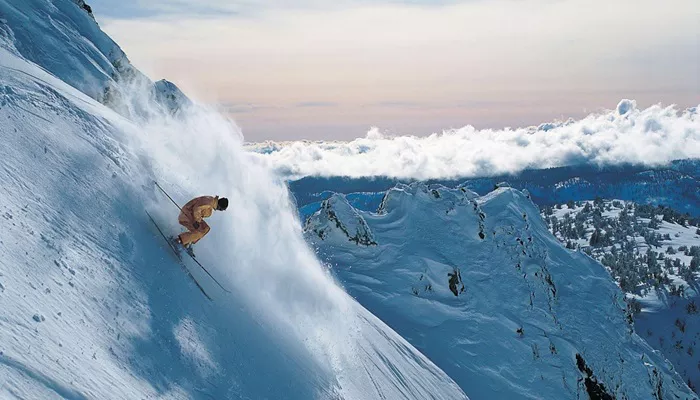Powder skiing is an exhilarating experience that allows skiers to float effortlessly on soft, untouched snow. However, turning in deep powder is a skill that requires specific techniques to maintain balance, control, and flow. Unlike skiing on groomed runs, where the edges of the skis carve into hard-packed snow, powder skiing demands a different approach to ensure smooth turns and efficient movement. This guide will provide a detailed breakdown of how to turn in powder skiing, covering essential techniques, body positioning, and common mistakes to avoid.
Understanding the Challenges of Powder Skiing
Before diving into the technical aspects of turning, it is important to understand why skiing in powder differs from skiing on packed snow:
Increased Resistance: Powder snow provides more resistance than groomed runs, making it harder to initiate and complete turns.
Less Edge Control: Unlike firm snow, where edges dig in for grip, powder requires a more subtle weight shift to steer the skis.
Balance and Floatation: Maintaining balance and staying on top of the snow is crucial to avoid sinking or getting stuck.
Rhythm and Flow: Successful powder skiing involves maintaining a smooth, rhythmic motion rather than making abrupt stops and turns.
With these challenges in mind, let’s explore the techniques needed to master turning in powder skiing.
1. Choosing the Right Equipment
Proper gear makes a significant difference in powder skiing. Here are some key considerations:
a) Ski Selection
Wider Skis: Choose skis with a wide waist (100mm+ underfoot) for better floatation.
Rockered Tips and Tails: Rocker technology helps skis stay above the snow and makes turning easier.
Soft Flex: A slightly softer ski flex enhances maneuverability in deep snow.
b) Bindings and Boots
Set Bindings Slightly Back: A rearward binding position helps keep the ski tips from diving into the snow.
Stiff Boots: Provide better control and responsiveness in deep powder.
2. Proper Stance for Powder Skiing
A balanced and adaptive stance is essential for successful powder turns:
a) Keep Your Weight Centered
Unlike hard-pack skiing, where forward pressure on the shins is crucial, powder skiing requires a more centered stance.
Too much forward pressure can cause the ski tips to dive, while leaning back excessively can lead to loss of control.
b) Keep Your Skis Closer Together
Keeping skis closer together increases stability and prevents one ski from sinking deeper than the other.
A natural, hip-width stance helps maintain balance and control.
c) Engage Your Core and Stay Relaxed
Keep your body loose and flexible to absorb terrain variations.
Engage your core to maintain stability without tensing up.
3. The Technique for Turning in Powder
Turning in powder skiing involves subtle weight shifts, smooth transitions, and rhythm. Here’s how to do it effectively:
a) Initiating the Turn
Start with a Gentle Weight Shift: Rather than forcing a hard edge, shift your weight slightly to the new turning ski.
Engage Both Skis: Unlike carving on groomers, powder skiing relies on even pressure across both skis.
Use a Gentle Up and Down Motion: A slight upward movement (unweighting) helps release the skis from the snow, making it easier to pivot into the turn.
b) Executing the Turn
Steer with Your Hips and Feet: Powder turns should be initiated with a smooth rotation of the lower body rather than an aggressive edge set.
Maintain a Continuous Flow: Avoid abrupt stops; instead, transition smoothly from one turn to the next.
Let the Skis Float: Allow the natural shape of the skis to guide you through the turn rather than forcing an edge.
c) Completing the Turn
Gradually Shift Weight to the New Outside Ski: This helps maintain stability and control.
Absorb the Snow’s Resistance: Use your knees and ankles to manage the natural resistance of the powder.
Prepare for the Next Turn: Keep your upper body facing slightly downhill to maintain momentum and flow.
4. Common Mistakes and How to Avoid Them
Powder skiing can be challenging, and beginners often make mistakes that hinder their progress. Here’s how to fix them:
a) Leaning Too Far Back
Problem: While a slight shift back helps with floatation, excessive backward leaning makes it difficult to control turns.
Solution: Keep weight centered over both skis and use subtle movements rather than leaning heavily backward.
b) Over-Rotating the Upper Body
Problem: Turning too much with the shoulders can throw off balance and reduce control.
Solution: Focus on initiating turns with the lower body while keeping the upper body stable.
c) Skiing with Skis Too Far Apart
Problem: A wide stance can cause one ski to sink while the other stays on top, leading to instability.
Solution: Keep your skis closer together to ensure even weight distribution.
d) Stopping Between Turns
Problem: Losing momentum between turns makes it harder to maintain rhythm and flow.
Solution: Focus on continuous, fluid movements without abrupt stops.
5. Advanced Tips for Mastering Powder Turns
Once you have the basics down, refine your technique with these advanced tips:
a) Use a Gentle Bouncing Motion
Lightly flexing and extending your legs helps release the skis from the snow and makes transitions smoother.
b) Control Speed with Turn Shape
Instead of forcing abrupt stops, use wider, S-shaped turns to control speed naturally.
c) Keep Your Hands in Front
Having your hands in front of your body helps with balance and ensures proper weight distribution.
d) Practice on Lower-Angle Slopes First
If you’re new to powder skiing, start on moderate slopes to build confidence before attempting steeper terrain.
Conclusion
Turning in powder skiing requires a unique approach compared to skiing on groomed runs. By using a balanced stance, engaging both skis, and maintaining smooth transitions, you can master powder turns and enjoy the exhilarating experience of floating through deep snow. Avoid common mistakes like leaning too far back or over-rotating your upper body, and focus on maintaining rhythm and flow. With practice, turning in powder will become second nature, allowing you to explore untouched terrain with confidence and ease.

